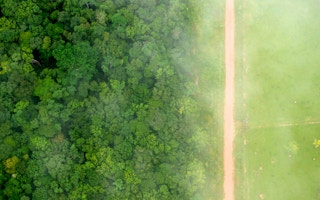Mining is one of the top drivers of deforestation globally, with huge swaths of forest being cleared for excavation pits, access roads and workers’ settlements. Yet details about mining’s environmental impact continue to go underrepresented — or unnoticed — even as the sector grows.
Mineral extraction has doubled since the turn of the century, increasingly pushing into tropical rainforests and protected areas in places like the Amazon and Cerrado. But a new WWF report says there are still considerable discrepancies about how mining-related deforestation is occurring, and why.
“Metals are important for the development of human civilisation and the life we live today. But the footprint left by the extraction of these commodities has a heavy toll on ecosystems,” said WWF Mining Global Lead Tobias Kind-Rieper. “…Mining and its associated infrastructure must be recognised as key causes of deforestation and biodiversity loss.”
An overwhelming majority of the deforestation that takes place as a result of mining can be traced back to just two commodities: gold and coal. Together, they resulted in an estimated 6,877 square kilometres (4,273 square miles) of forest loss over the last two decades. Other major minerals include bauxite, iron ore and copper.
Some countries, most notably Suriname, have even seen mining become the top driver of deforestation, surpassing more common causes like agriculture and cattle, the report said. Neighbouring Guyana has experienced a similar trend.
Mining operations need to clear the forest to dig the pit where the minerals will be extracted, as well as create access roads for heavy machinery coming and going from the site. But often, other, indirect activities leading to deforestation have been overlooked. Mining requires energy, processing and storage, the report said, which means infrastructure has to be built near the mine site.
“
The forest is not only a fundamental source of oxygen and water capture, not only an ecosystem where many plant and animal species are found, but also a source of employment for thousands of families. When there’s a mining concession in those kinds of areas, all of that is at risk.
Cecilia Navarro, professor, Mexican Civil Council for Sustainable Forestry
The operations also require a workforce, resulting in in-migration and the expansion of settlements. As they grow, so does development of the area, leading to increased deforestation, the report said. Between 10 per cent and 33 per cent of the world’s forests may be affected by these indirect impacts of mining.
In Brazil’s Tapirapéaquiri National Forest, satellites captured roads, buildings and dams associated with a mining operation, the report said. As work progressed between 2008 and 2022, development continued to expand into neighbouring areas, resulting in over 25 square kilometres (15.5 square miles) of deforestation.
“The indirect deforestation impacts of mining can far exceed direct impacts, but are rarely taken into account in planning and policymaking,” the report said. “These impacts are not yet given sufficient consideration in environmental impact assessments and reporting.”
Most mining-related tropical forest loss assessed since 2000 has taken place over the last five years, the report said, much of it in Latin American countries like Brazil, Peru, Colombia and Venezuela. Countries in other parts of the world, including Indonesia, Russia, Canada, the US, Australia, Ghana and Myanmar, have also been hit badly.
In those countries, the report said there is a concerning trend of downgrading and downsizing protected areas to allow for mining.
Globally, downgrading and downsizing has impacted 130 million hectares (321 million acres) of protected land in nearly 70 countries, according to Conservation International. In Tanzania, the Selous Game Reserve was downsized to allow for uranium mining. And in Brazil, there are 219 protected areas that overlap with mining claims, the report pointed out.
But mineral-consuming countries are also to blame for forest loss, the report said. China and the US drive around 30 per cent of mining-related deforestation, while the combined demand from European Union countries accounts for 14 per cent of the global total, making it the second-worst offender overall. According to the report, 85 per cent of the EU’s deforestation footprint is located abroad, much of it in at-risk areas like the Amazon rainforest.
“The forest is not only a fundamental source of oxygen and water capture, not only an ecosystem where many plant and animal species are found, but also a source of employment for thousands of families,” said Cecilia Navarro of the Mexican Civil Council for Sustainable Forestry. “…When there’s a mining concession in those kinds of areas, all of that is at risk.”
WWF’s report calls for increased funding for research into the indirect impacts of mining-related deforestation so that policymakers can create better environmental regulations for the sector. It also said that environmental impact assessments need to account for the indirect factors driving deforestation, since they have so far mostly gone overlooked.
It also said that consuming countries need to work on bringing down the demand for minerals in general.
“China, the EU and USA must take concrete steps towards bringing down overall demand for mineral products and set targets for the reduction of primary mineral commodities across all economic policies and strategies,” the report said.
This story was published with permission from Mongabay.com.










